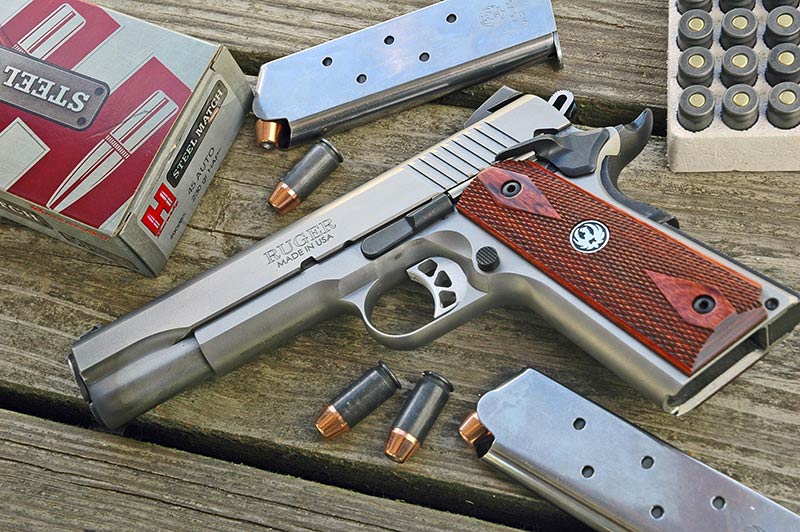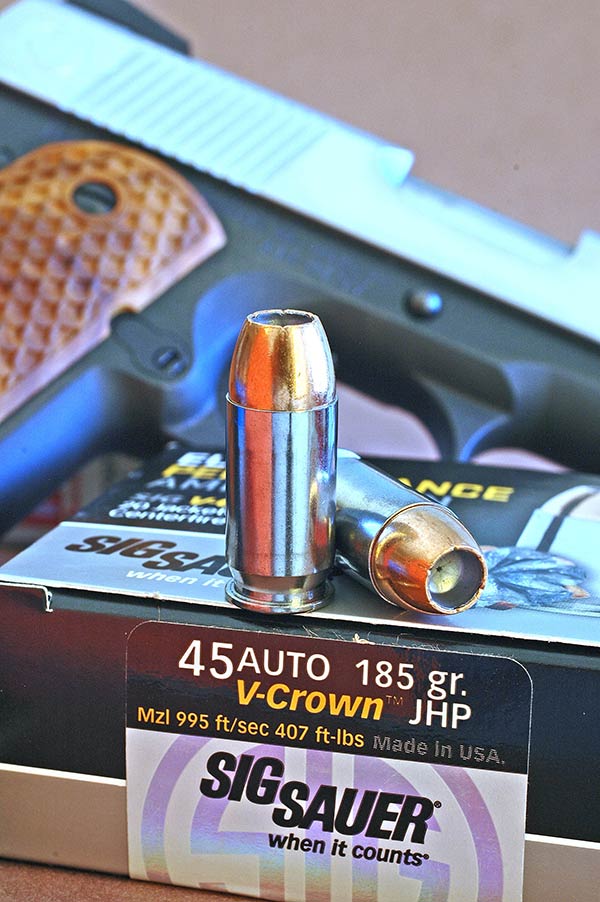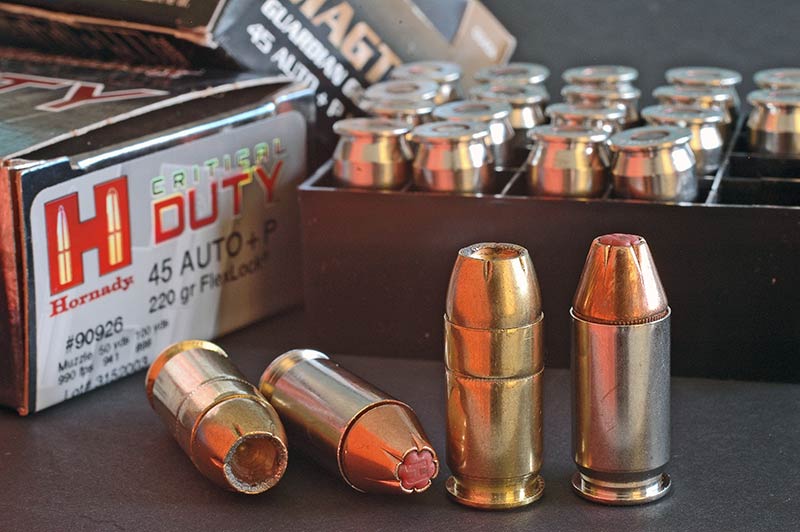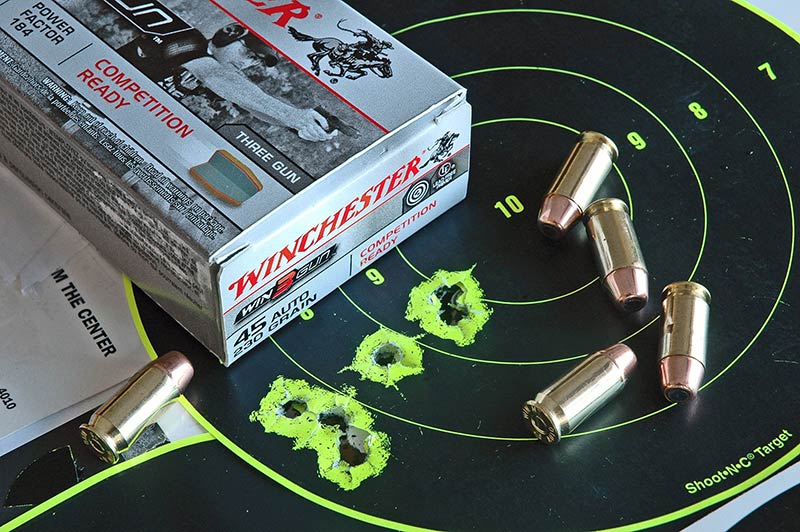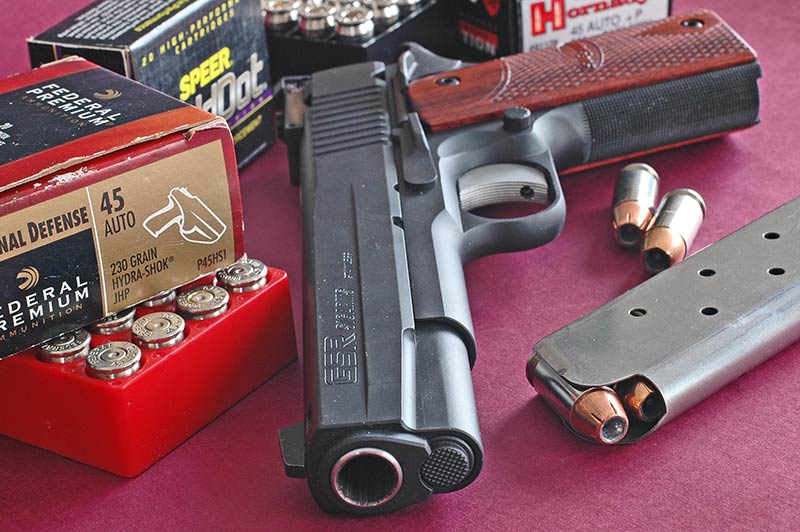Feeding The Forty-Five
Millions Or Billions? After Many, Many Rounds And A Century,
We Know All About The .45 ACP… Don’t We?
The first thing to learn is that you can’t learn everything. I’ve learned a little about 1911’s. Forty years ago I built a couple from parts. A local farmer bought one for $100. With the other I could hit an oil can most times at 20 steps. Slowly it dawned there was more to this pistol and its squat .45 cartridge. Not that the history had escaped me.
John Browning’s genius appeared early on. While in his 20’s, John had designed and, with his brothers, was building a dropping-block rifle the equal of a Remington or a Sharps. Winchester VP Thomas Bennett found him in Ogden and bought all rights to the rifle, then kept him busy for the next 17 years. Browning fathered Winchester’s 1886 and 1892, 1894 and 1895 rifles. He “…talked in inches, like a carpenter.” But rendered in steel, his brilliant designs worked silkily. Every time.
John Browning built his first autoloading pistol in 1894, shipping it to Colt the next year. Another Browning .38 appeared in Colt’s 1900 catalog as the first US-made autoloader, its signal feature a slide mated to the frame by rails. The 1902 Military Model followed. The Moro insurrection in the Philippines sorely tested the .38 Colt. Browning responded with pistols in .45 ACP, which he’d helped develop. The exposed-hammer Colt Model 1905 drew a government order for 200. Eventually 6,100 were built.
Refinements resulted in the Model 1911, slated for military tests March 3rd of that year. Browning worked at the Hartford plant with Colt engineer Fred Moore to ready the pistol. It endured 6,000 firings in 100-round strings, then an acid bath, dusting, then more shooting — some with deformed cartridges.
John Browning’s Colt pistol would serve the US through both world wars, Korea and Vietnam.
After WW II, surplus 1911’s fetched $39.50. Weep over current prices, if you will, but the march of time has blessed us with ammunition far superior to the 230-grain ball cartridges of the 1950’s.
Albeit they carve narrow tracks in soft tissue, heavy hardball .45 bullets crush bone. They’re also feed-ramp friendly. “Get a 230 round-nose pointed toward the barrel, and it slides right into the chamber,” nods Carroll Pilant, who, besides representing Sierra bullets for decades, is an accomplished competitive shooter.
But traditional hardball ammo has liabilities too. Bullets exit soft targets, endangering people and property beyond. The stiff recoil both slows recovery and can make practice unpleasant for some. Surplus hardball is affordable, so still popular; but faster hollowpoint loads are edging it out for competition and self-defense.
Ideas
“Designing open-nose .45 bullets isn’t easy,” says Dave Emary, Hornady’s resident guru on such matters. He notes the 1911 and the .45 ACP round both pose challenges. “The pistol’s ramp is steep. And it varies among 1911’s, especially custom guns, which can have other idiosyncrasies. Then there’s the .45’s fat, slow bullet.” Dave and his Hornady team developed Critical Defense and Critical Duty loads for the .45 and other pistol and revolver cartridges. “We had to give FlexLock and XTP bullets a nose cavity ensuring the right mix of upset and penetration. We radiused the mouth to help with feeding.”
Hornady offers 200-grain XTP’s in standard and +P loads. The 185-grain hollowpoints in Critical Defense ammo have pure lead cores for reliable upset at low impact speed and, says Emary, “…the 11″ to 12″ of gelatin penetration we want.”
Critical Duty .45 loads feature 220-grain FlexLock bullets with an InterLock band and about the same antimony (core) content as rifle bullets. “FBI protocol requires they penetrate 14″ to 16″ in gelatin, and perforate metal and glass,” Dave explains. “Jackets on these hollowpoints are gilding metal, as on Critical Defense bullets; but they’re thicker. The nose is designed to sheer on slanted windshields, the shank continuing on a straight path.” Energy, recoil and cost of Critical Duty loads are, predictably, higher than those of Critical Defense ammunition. Soft polymer plugs in the nose cavities of both bullet types prevent clothes or other material from plugging the nose on entry.
Now, this seems counterintuitive. When material enters the cavity on impact, isn’t the nose forced open? Verily, clothing cut by bullet noses impairs upset. Ditto wood. I’ve tested .45 JHP’s in railroad ties, expecting them to mushroom fully, perhaps fragment and stop shallow. Instead they behaved like solids, driving deep with little deformation, their noses packed tight with wood.
“The polymer in our FlexLock noses is very soft,” Emary points out. “It exerts the pressure you’d get from flesh or gelatin. A hydraulic-like jolt initiates upset.”
Details
Nosler also installs polymer pegs in its .45 ACP +P Defense loads. “We stayed with the 230-grain weight for more up-close impact and deeper penetration,” says Zach Waterman. “We bond core-to-jacket for maximum weight retention.” The tip is relatively hard. “You can also get Defense ammo with a 230-grain JHP Bonded bullet. No tip. The cavity isn’t as deep.” Nosler catalogs 185- and 230-grain .45 Match Grade JHP’s. “They’re our best sellers,” confirms Waterman.
Zach agrees with Dave the 9mm is blasting by the .45 ACP in sales. “New bullet designs and powders give the 9 real stopping power. You get less recoil and more rounds in the magazine, less ammo weight on your belt too.”
“I’m actually a .40 S&W fan,” grins Carroll Pilant. “My STI .40’s shoot well, especially with the 190-grain bullets Sierra once made.” But most shooters are leaning light with the .40 too. Carroll’s long experience with the .45 has steered him the other way. He’s fired boatloads of .45’s, most with 230-grain bullets, and favors Sierra’s 230 Power Jacket JHP. “Heavy bullets afford more bearing surface,” he points out.
“That can mean better shank alignment during bore travel and better accuracy. It also adds latitude in seating depth. Adjusting depth can make a big difference in the way a pistol feeds. Deep seating makes a cartridge short, so it may nose up prematurely in the magazine and jam at the top of the chamber. Seat too shallow, and the long cartridge can bite the bottom of the ramp. Shooters frustrated by balky feeding have told me after tending seating depth, their problems went away. You need 100-percent reliability from a self-loader. You’ll get there more easily if your bullet shanks are long enough to tweak seating.”
Carroll applies a taper crimp, on bullets with or without a cannelure. “Another advantage of the long bearing surface of heavy bullets is you don’t need an aggressive crimp into a cannelure. Friction in the case is often enough; a modest taper crimp ensures the bullets won’t move in recoil.”
Shooters who like 230’s can choose from myriad loads, FMJ and JHP (Federal alone lists seven!).
Incidentally, Sierra manufactures the V-Crown bullets loaded in SIG pistol ammunition. The 200-grain JHP for the .45 ACP is a cannelured bullet some will consider an ideal mid-weight missile for self-defense. For handloaders Sierra peddles V-Crown bullets in black boxes.
Lighter And Faster
Advocates of lighter bullets emphasize they kick less than 230’s. How much less, of course, depends on how hot you load. Pistol weight and dimensions also affect felt recoil. Ballistically, 185’s and 200’s seem a practical compromise: enough speed for reliable upset, but the weight and sectional density to ensure penetration and carry lethal energy beyond a 7-yard target. Ballistic coefficients? All miserably low. Figure .100 for a 185-grain JHP to .145 for a 230-grain of similar nose profile. Compare that with roughly .400 for a pointed 180-grain .30-bore rifle bullet! Because 50 yards is a long shot for a .45, BC matters much less than it does for rifles.
If you’re keen to wring the most speed from your .45 without battering the slide or bruising your palm, there are a few lighter, faster options. One is the Black Ops load from HPR. Ryan Nicholas explains HPR uses only top-end American-made components: Starline brass, St. Marks powders, CCI primers and bullets from the likes of Hornady and Sierra. “Our 150-grain lead-free .45 ACP load clocks 1,110 fps and carries over 360 foot-pounds of energy to 50 yards. It has a sintered metal core that fragments upon impact, shredding gelatin in a cavity as deep as 1″.” I’ve watched similar missiles from DRT spray metal particles into unfortunate ballistic blocks. The result is devastating.
Here are some sub-230-grain factory loads, frisky and mild, with muzzle velocities from 5″ barrels. Whatever your preferences as to bullet weight and style, you’ll find factory ammunition to match!
Where Will They Hit?
Unless you throttle velocity, reducing bullet weight can shift point of impact significantly. And as veteran shooters know, the effect in handguns is opposite that in rifles. The upward movement of a pistol barrel in recoil is quicker and more pronounced than in rifles. Slow bullets leave later than do fast bullets — thus, higher in the muzzle’s arc during recoil. Heavy bullets hit high. While I’ve found some exceptions to this rule, it’s still the rule.
The Ferocious Open Nose
In my youth, the .45 ACP was fearsome indeed. “One shot’ll take your arm off,” I heard from GI’s who may have fired a 1911. Or not. Police officers toting K-Frame S&W’s in .38 Special likewise thought a bigger bore an upgrade. A fellow who’d never worn a uniform assured me he’d never shoot a man with an expanding .45 ACP bullet because “it’s inhumane.” I wondered then at such logic — if, firing to stop a lethal threat, anyone would wish a kinder, gentler load. How’s that again?
Where will they hit?
Unless you throttle velocity, reducing bullet weight can shift point of impact significantly. And as veteran shooters know, the effect in handguns is opposite that in rifles. The upward movement of a pistol barrel in recoil is quicker and more pronounced than in rifles. Slow bullets leave later than do fast bullets — thus, higher in the muzzle’s arc during recoil. Heavy bullets hit high. While I’ve found some exceptions to this rule, it’s still the rule.
The Ferocious Open Nose
In my youth, the .45 ACP was fearsome indeed. “One shot’ll take your arm off,” I heard from GI’s who may have fired a 1911. Or not. Police officers toting K-Frame S&W’s in .38 Special likewise thought a bigger bore an upgrade. A fellow who’d never worn a uniform assured me he’d never shoot a man with an expanding .45 ACP bullet because “it’s inhumane.” I wondered then at such logic — if, firing to stop a lethal threat, anyone would wish a kinder, gentler load. How’s that again?


